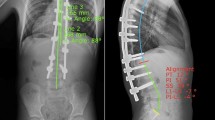Abstract
Objectives/Summary of Background Data
Segmental sublaminar spinal instrumentation without fusion results in guided growth and correction of deformity in early-onset scoliosis (EOS). The purpose of this study is to report the outcomes of a series of children with low-tone EOS that were treated surgically with a modification of a Luque trolley technique.
Methods
This study is a retrospective chart and radiographic review of a single-center series of 13 consecutive children who met inclusion criteria with documented progression of scoliosis greater than 25°. All children received surgical treatment with guided growth without fusion using a modified Luque trolley technique. The children’s preoperative, postoperative, and most recent radiographs were assessed for Cobb angle, T1–T12 and T1–S1 height, and sagittal alignment including proximal junctional kyphosis. Surgimap spine software was used for calibration and measurement purposes. Complications and need for repeat and/or secondary surgical procedures were recorded.
Results
The mean age at surgery was 7.4 years (4.6–10.5). On average, 15 segments (13–16) were instrumented. None of the children went on to a spontaneous fusion, and the average growth rate per year from T1–T12 and T1–S1 was 0.9 cm/y and 1.5 cm/y, respectively. The mean total growth from T1–T12 and T1–S1 was 22.3 cm (16.6–30.2) and 37.5 cm (30.1–46.4). A total of three additional surgeries were needed in two children to address complications. There were no mortalities.
Conclusions
Sublaminar guided growth is a safe and effective treatment in the Low Tone Neuromuscular subset of EOS. Follow-up studies failed to show signs of auto fusion, and implant failure was not observed in our cohort. All children displayed growth postoperatively without the need for multiple distraction-based surgeries. Guided growth minimizes the risks associated with multiple surgical procedures while maintaining correction and allowing for near-normal rates of spinal growth.
Similar content being viewed by others
References
Williams BA, Matsumoto H, McCalla DJ, et al. Development and initial validation of the Classification of Early-Onset Scoliosis (CEOS). J Bone Joint Surg Br 2014;96:1359–67.
Thompson G, Berenson F. Other neuromuscular disorders. In: Weinstein S, Flynn J, editors. Philadelphia, PA: Lippincott Wiliams & Wilkins; 2006.
Merlini L, Granata C, Bonfiglioli S, et al. Scoliosis in spinal muscular atrophy: natural history and management. Dev Med Child Neurol 1989;31:501–8.
Rodillo E, Marini ML, Heckmatt JZ, et al. Scoliosis in spinal muscular atrophy: review of 63 cases. J Child Neurol 1989;4: 118–23.
Russman BS, Melchreit R, Drennan JC. Spinal muscular atrophy: the natural course of disease. Muscle Nerve 1983;6:179–81.
Aprin H, Bowen JR, MacEwen GD, et al. Spine fusion in patients with spinal muscular atrophy. J Bone Joint Surg Am 1982;64: 1179–87.
Schwentker EP, Gibson DA. The orthopaedic aspects of spinal muscular atrophy. J Bone Joint Surg Am 1976;58:32–8.
Karol LA, Johnston C, Mladenov K, et al. Pulmonary function following early thoracic fusion in non-neuromuscular scoliosis. J Bone Joint Surg Am 2008;90:1272–81.
Dimeglio A, Canavese F. The growing spine: how spinal deformities influence normal spine and thoracic cage growth. Eur Spine J 2012;21:64–70.
DiMeglio A, Canavese F, Charles YP. Growth and adolescent idiopathic scoliosis: when and how much? J Pediatr Orthop 2011;31: S28–36.
Skaggs DL, Akbarnia BA, Flynn JM, et al. A classification of growth friendly spine implants. J Pediatr Orthop 2014;34:260–74.
Eberle CF. Failure of fixation after segmental spinal instrumentation without arthrodesis in the management of paralytic scoliosis. J Bone Joint Surg Am 1988;70:696–703.
Granata C, Cervellati S, Ballestrazzi A, et al. Spine surgery in spinal muscular atrophy: long-term results. Neuromuscul Disord 1993;3: 207–15.
Luque ER. Paralytic scoliosis in growing children. Clin Orthop Relat Res 1982;163:202–9.
Mardjetko SM, Hammerberg KW, Lubicky JP, et al. The Luque trolley revisited. Review of nine cases requiring revision. Spine (Phila Pa 1976) 1992;17:582–9.
Yang JS, McElroy MJ, Akbarnia BA, et al. Growing rods for spinal deformity: characterizing consensus and variation in current use. J Pediatr Orthop 2010;30:264–70.
Luque ER. Segmental spinal instrumentation for correction of scoliosis. Clin Orthop Relat Res 1982;163:192–8.
Brown JC, Zeller JL, Swank SM, et al. Surgical and functional results of spine fusion in spinal muscular atrophy. Spine (Phila Pa 1976) 1989;14:763–70.
Daher YH, Lonstein JE, Winter RB, et al. Spinal surgery in spinal muscular atrophy. J Pediatr Orthop 1985;5:391–5.
Phillips DP, Roye Jr DP, Farcy JP, et al. Surgical treatment of scoliosis in a spinal muscular atrophy population. Spine (Phila Pa 1976) 1990;15:942–5.
McAfee PC, Lubicky JP, Werner FW. The use of segmental spinal instrumentation to preserve longitudinal spinal growth. An experimental study. J Bone Joint Surg Am 1983;65:935–42.
Rinsky LA, Gamble JG, Bleck EE. Segmental instrumentation without fusion in children with progressive scoliosis. J Pediatr Orthop 1985;5:687–90.
Ouellet J. Surgical technique: modern Luque trolley, a self-growing rod technique. Clin Orthop Relat Res 2011;469:1356–67.
Chandran S, McCarthy J, Noonan K, et al. Early treatment of scoliosis with growing rods in children with severe spinal muscular atrophy: a preliminary report. J Pediatr Orthop 2011;31:450–4.
Akbarnia BA, Marks DS, Boachie-Adjei O, et al. Dual growing rod technique for the treatment of progressive early-onset scoliosis: a multicenter study. Spine (Phila Pa 1976) 2005;30:S46–57.
Sankar WN, Skaggs DL, Yazici M, et al. Lengthening of dual growing rods and the law of diminishing returns. Spine (Phila Pa 1976) 2011;36:806–9.
DiMaggio C, Sun LS, Li G. Early childhood exposure to anesthesia and risk of developmental and behavioral disorders in a sibling birth cohort. Anesth Analg 2011;113:1143–51.
Author information
Authors and Affiliations
Corresponding author
Additional information
Author disclosures: SR (consultant from Medicrea Spine and OrthoPediatrics Spine), JS (other from Arthrex, Inc., Naples, FL, outside the submitted work), BS (none).
IRB approval granted.
Sources of support and funding: None.
Rights and permissions
About this article
Cite this article
Rosenfeld, S., Schlechter, J. & Smith, B. Achievement of Guided Growth in Children With Low-Tone Neuromuscular Early-Onset Scoliosis Using a Segmental Sublaminar Instrumentation Technique. Spine Deform 6, 607–613 (2018). https://doi.org/10.1016/j.jspd.2018.02.012
Received:
Revised:
Accepted:
Published:
Issue Date:
DOI: https://doi.org/10.1016/j.jspd.2018.02.012




